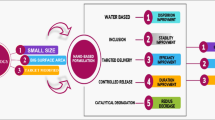Abstract
This study investigated the effects of some essential oils onLimantria dispar (Lepidoptera: Lymantridae, gypsy moth) larvae, one of the most serious pests of cork oak forests. The essential oils were first formulated as oil in water (o/w) emulsions and used in laboratory bioassays to assess their lethal concentration (LC50). Microcapsules containing the most promising, oils (Rosmarinus officinalis andThymus herba-barona) were then prepared by a phase separation process, followed by freeze-drying. The formulations thus obtained, characterized in terms of essential oil content and composition, morphology, storage stability, and release profile, were tested on gypsy moth larvae. The results showed that the tested oils possess interesting larvicidal effects that make them suitable for application in integrated control strategies. The microencapsulation process gave high encapsulation yields (over 98%) with both essential oils, which have different chemical compositions. The microcapsules had toxic effects at a concentration similar to that usually employed for localized treatments with microgranular synthetic pesticides. Toxicity appeared to be maximized when the microparticles adhered to the typical hair structures of several defoliator families. These formulations seem to be able to protect the core material against environmental agents and could be considered for use in controlled drug release systems. The natural active principles they contain could provide an alternative system in insect pest control.
Similar content being viewed by others
References
Pillmoor JB, Wright K, Terry AS. Natural products as a source of agrochemicals and leads for chemical synthesis. Pestic Sci. 1993;39:131–140.
Bazzoni E, Sanna-Passino G, Moretti MDL. Essential oils and other control techniques against stored product insects. In: Majumdar DK, Govil JN and Singh VK, eds., Recent Progress in Medicinal Plants, Vol. 8 Phytochemistry and Pharmacology II. Houston, TX: Sci Tech Publishing LLC; 2002:313–342.
Bathal SS, Singh D, Dhillon RS. Effect of crude root oils ofInula racemosa andSaussurea lappa on feeding, survival and development ofSpodoptera litura (Lepidoptera: Noctuidae) larvae. Eur J Entomol. 1993;90(2):239–240.
Park SJ, Lee SG, Shin SC, Lee BJ, Ahn YJ. Larvicidal and antifeeding activities of oriental medicinal plant extracts against four species of forest insect pests. Appl Entomol and Zool. 1997;32(4):601–608.
Larocque N, Vincent C, Belanger A, Bourassa JP. Effects of tansy essential oil fromTanacetum vulgare on biology of oblique-banded leafroller,Choristoneura rosaceana. J Chem Ecol. 1999;25(6):1319–1330.
Marimuth S, Gurusubramanian G, Krishna SS. Effect of exposure of eggs to vapours from essential oils on egg mortality, development and adult emergence inEarias vittella (F.) (Lepidoptera: Noctuidae). Biol Agr Horticult. 1997;14(4):303–307.
Naumann K, Isman MB. Evaluation of neemAzadirachta indica seed extracts and oils as oviposition deterrents to noctuid moths. Entomol Experimental Appl. 1995;76:115–120.
Landolt PJ, Hofstetter RW, Biddick LL. Plant essential oils as arrestants and repellents for neonate larvae of the codling moth (Lepidoptera, Tortricidae). Environ Entomol. 1999;28(6):954–960.
Moretti MDL, Peana AT, Franceschini A, Carta C. In vivo activity ofSalvia officinalis oil against Botrytis cinearea. J Essent Oil Res. 1998;10:157–160.
Markus A. Advances in the technology of controlled-release pesticide, formulations. In Benita S, ed., Drugs and the Pharmaceutical Sciences, Vol. 73, Microencapsulation: Methods and Industrial Applications. New York, NY: Marcel Dekker; 1996:73–91.
Kydonieus AF. Controlled Release Technologies: Methods, Theory, and Applications. Vols. 1 and 2. Boca Raton, FL: CRC Press; 1980.
Luciano P, Lentini A, Prota R. Un quinquennio di prove di lotta microbiologica allaLymantria dispar (L.). Paper presented at: Atti XVII Congresso Nazionale Italiano di Entomologia 1994, Udine, Italy.
Margalit J, Markus A, Pelah Z. Effects of the persistence ofBacillus thuringiensis var. israelensis serotype H-14. Appl Microbiol Biotechnol. 1984;19:198.
Greenblatt HC, Dombroski M, Klishevich W. Encapsulation and controlled release. London, England: Special Publicationof-Royal Chemical Society; 1993.
Ribeiro A, Arnoud P, Frazao S, Venacio F, Chaumeil JC. Development of vegetable extracts by microencapsulation. J Microencapsul. 1997;14:735–742.
Determination of essential oils in vegetable drugs. European Pharmacopoeia. 4th ed. Strasbourg, France: European Directorate for the quality of Medicines, Council of Europe Editions; 2002: 183–184.
Van Den Dool H, Kratz P. A generalisation of the retention index system including linear temperature programmed gas-liquid partition chromatography. J Chromatogr. 1963;11:463–471.
Hamilton MA, Russo RC, Thurston RV. Trimmed Spearman-Karber Method for estimating median lethal concentrations in toxicity bioassays. Environ Sci Technol. 1977;11(7):714–719.
Abbott WS. A method of computing the effectiveness of insecticide. J Econ Entomol. 1925;18:265–267.
Duquemin SJ, Nixon JR. The effect of sodium lauryl sulphate, cedrimide and polysorbate 20 surfactants on complex coacervate volume and droplet size. J Pharm Pharmacol. 1985;37:698–702.
Lee SG, Kim SI, Ahn YJ, Kim JB, Lee BY. Effectiveness of carvacrol derived fromThujopsis dolabrata var. hondai sawdust againstThecodiplosis japonensis (Diptera: Cecidomyiidae). Pestic Sci. 1997;49(2):119–124.
Karpouhtsis I, Pardali E, Feggou E, Kokkini S, Scouras ZG, Mavragani-Tsipidou P. Insecticidal and genotoxic activities of oregano essential oils. J Agric Food Chem. 1998;46(3):1111–1115.
Ulthee A, Kets EPW, Smid EJ. Mechanisms of action of carvacrol on the food-borne pathogenBacillus cereus. Appl Environ Microbiol. 1999;65(10):4606–4610.
Knowless BH. Mechanism, of action ofBacillus thuringiensis δ-endotoxins. Adv Insect Physiol. 1994;24:275–308.
Author information
Authors and Affiliations
Corresponding author
Rights and permissions
About this article
Cite this article
Moretti, M.D.L., Sanna-Passino, G., Demontis, S. et al. Essential oil formulations useful as a new tool for insect pest control. AAPS PharmSciTech 3, 13 (2002). https://doi.org/10.1208/pt030213
Received:
Accepted:
DOI: https://doi.org/10.1208/pt030213




